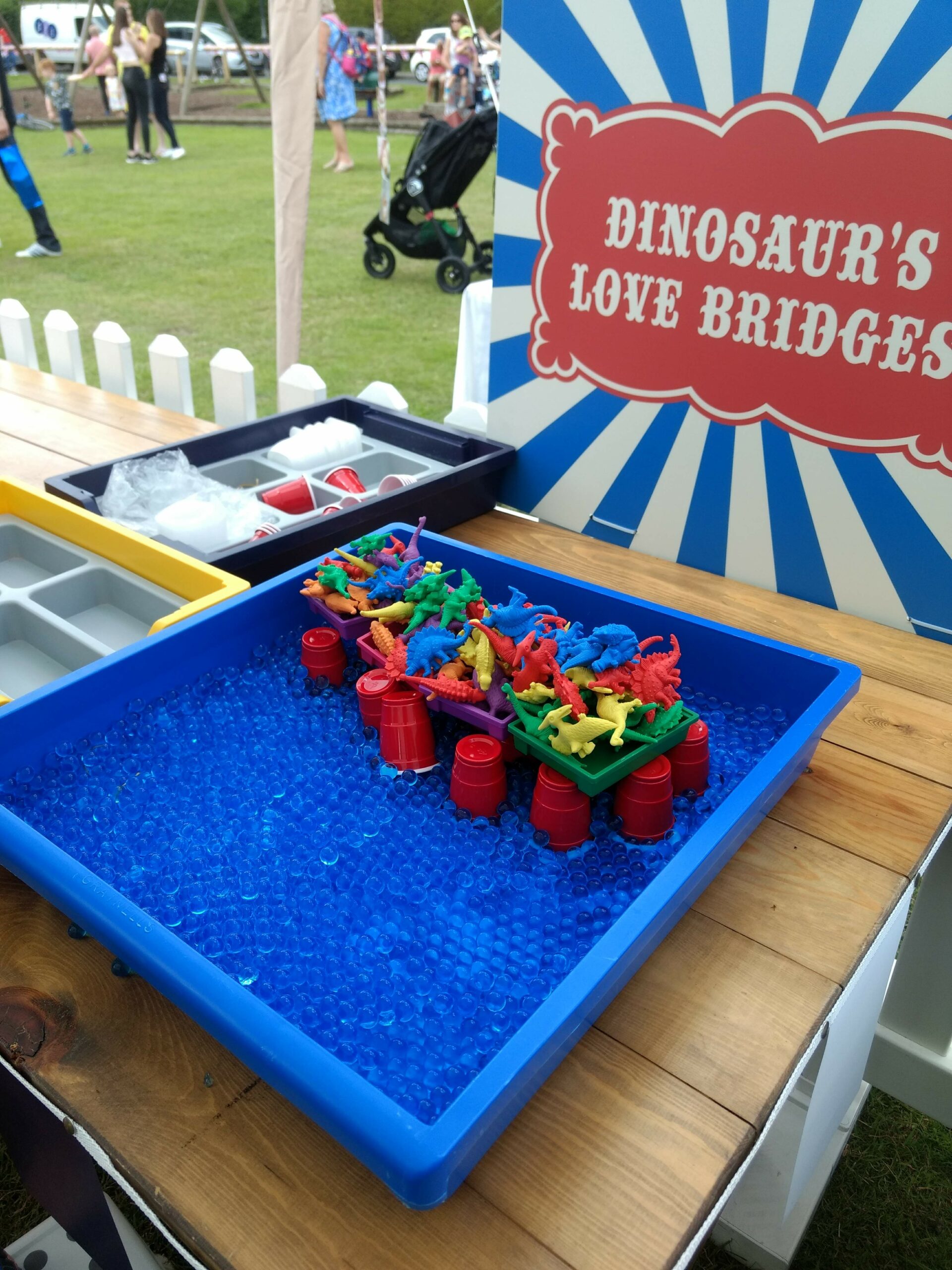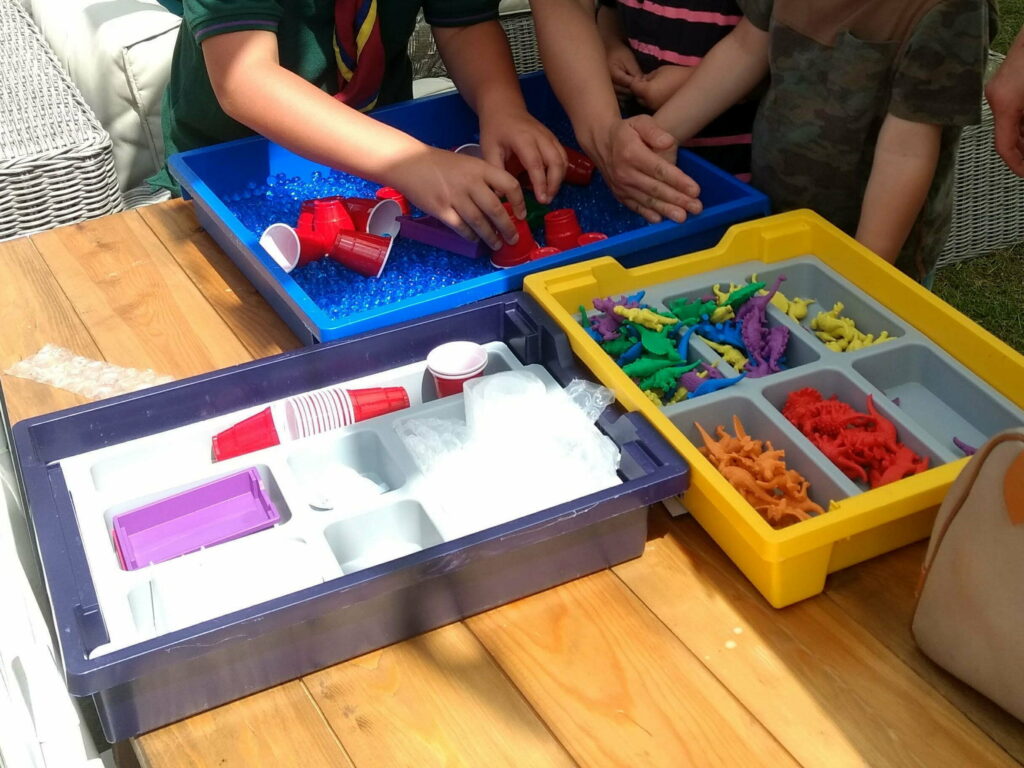
Dinosaur bridges
Planning a school fair, looking for some fundraising activities or new ways to keep your young people entertained over the summer? Gratnells Learning Rooms has gone carnival crazy to support good causes and engage the community through fun games and STEM activities.


Learning outcomes
You will be able to
- Work as a team to build a bridge that supports twenty or more dinosaur counters.
- Describe the features of the most effective bridge.
- Accurately count the total number of dinosaur counters your bridge supports (up to a maximum of 90).
You will need
- 1 x Shallow Gratnells tray (F1) with office insert and lid
- 1 x Shallow Gratnells tray (F1) with 6-section insert and lid
- 1 x Gratnells trays A3 paper (D3) tray
- Blue water beads sufficient to half fill the A3 paper tray when hydrated (use biodegradable beads)
- 4 x Small cardboard tubes
- 20 x Lollypop or craft sticks
- 6 x Plastic shot glasses
- 4 x Recycled yoghurt pots
- 5 x Elastic bands
- 2 x Strip of bubble wrap
- 2 x Strip of packing material
- 1 x Blue Tac pack
- 1 x Full set of Dinosaur Counters from Edx Education
- 1 x Instruction sheet printable
- A selection of small prizes of your choosing
Tip: Bubble wrap and packing material could be substituted for recycled strips of cardboard, use recycled and reusable materials wherever possible for the construction materials and substitute items from the list above with anything suitable that you have available.
Preparation
- Make up the water beads up at least 3 hours ahead of the session, you will need between one-quarter and one-half cup of water beads plus 8 to 12 cups of water, but this will vary by brand of bead. Put the hydrated water beads into the A3 paper tray.
- Organise all construction materials into the shallow tray with office insert and put the lid on.
- Organise the dinosaur counters into the shallow tray with 6-section insert and put the lid on.
- Print and laminate (optional) the instruction sheet. <hyperlink to download>
What to do
- You have five minutes to complete this STEM challenge.
- Dinosaurs migrate too! Help the dinosaurs escape the long dark winter and get to land with more food and water by building a bridge over the river (water bead tray).
- If any dinosaurs fall in the river they will be swept away. You cannot pick them up out of the water once they have fallen.
- When the allocated time for the activity has ended, count up how many dinosaurs are left standing on your bridges and how many are in the river.
- Take photographs of your work.
- Get 20 or more dinosaurs on your bridge to win a prize.
- Write the total number of dinosaurs on the bridge at the end of the five minutes next to your team name on the leader board.
- Take the bridge apart and put everything back into their original trays ready for the next participants.
What is happening
People have been designing and building bridges for hundreds of years. Bridges need to be able to support weight so that people and loads may cross them. Force is exerted on bridges from above (vertically) and sideways (horizontally). The relationship between the forces acting on the bridge are very important, too much tension (pulling force) or too much weight or applied force (push) will cause a bridge to sag or buckle.
The most important shape in bridge engineering is the triangle, because of its strength. You could have a go at testing this too.
There are different types of bridge, which rely on different engineering principles for their success. You may like to look up truss, arch, cable-stayed and suspension bridges and have a go at building different types. They all deal with forces and weight in different ways.
Other things to try
- Modify the challenge to make a bridge for a specific number of dinosaurs (e.g. 10-15) using the least amount of construction materials possible (efficiency challenge).
- Make an even longer bridge! Collect a range of recycled materials to add to those you have already. Make a bridge diagonally across the Gratnells A3 paper tray and supersize your challenge!
- Share your photographs with your friends and family, discuss the different bridge designs, were some more successful then others?
- Research different bridge designs and the engineers who designed and built them, learn as much as you can about what makes for the best bridge design. Repeat the challenge using what you know and construct even better bridges.
- Share the photographs of your bridges on social media using #WhatsInMyTray
- Try our other STEM challenges, we have sailboats, rockets, cargo boats and buggies just for starters
Health and Safety
As with all Gratnells Learning Rooms What’s In My Tray Activities, you should carry out your own risk assessment prior to undertaking any of the activities or demonstrations.
